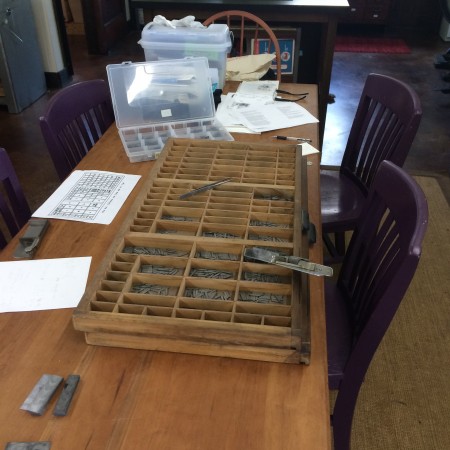In my role as the fine arts librarian at Baylor University, I’ve been building a teaching collection of artist’s book over the last eight years that now totals about 700 titles. You can see more about the collection here.
I have just completed my own artist’s book, entitled KnownUnknown, which is on it’s way to a gallery exhibition in Denver (Abecedarian Gallery). The show will include about fifty works from artists around the world, including several other first timer artist’s books exhibitors from Waco.
Working on my own artist’s book is something I’ve been chewing on for several years and I appreciate the encouragement of the many artists, book arts dealers, and colleagues. I also appreciate my wonderful partner, Ann, for her patience during the countless hours away from the family that this project demanded.
KnownUnknown explores the fragmented realities wherein the people around us are both known and unknown. Pairing stories of a grandfather I never knew and glimpses of people known through social media, this work illuminates the dichotomy of knowing intimate details of someone while at the same time knowing little or nothing of substance about them.
The work was created at BlackHare Studio, in Robinson, Texas. Type was handset using Cloister Lightface, Univers, & Franklin Gothic. Letterpress printed on a No. 4 Vandercook press. Pages include image transfers & hand drawn icons. Outer structure incorporates acrylic monoprinting (with color choice referencing the social media spheres contained in the texts).
I chose the blizzard book structure (invented by Hedi Kyle) for this work because it afforded the reader control over the order of the fragmentary texts rather than a linear, fixed order.
While much of the text was self-generated, some came from personal archival documents related to my grandfather and some came from posts on Facebook and Twitter. My image collaboration included photographs taken by various and unknown photographers. I also collaborated with letterpress printer and fellow exhibitor Virginia Green on setting type and printing.
KnownUnknown was designed using the Artist’s Book Ideation Cards by Barbara Tetenbaum and Julie Chen. Randomly selected in various categories, the Ideation Cards provide prompts in various categories. Cards used for this project included: PAPER (pretreated), LAYOUT (minimal or restrained), IMAGE (collaborate with another artist), TEXT (self generated), TECHNIQUE (mixed media), COLOR (single color), and STRUCTURE (accordion… ed. note: hidden at the core of the blizzard book structure!). From deck two of the Ideation Cards (Adjectives), I drew cards containing the following that I incorporated into this project: mysterious, fragmented, pocketed, and self reflexive.
Images of the completed work (photo credits: Bob Smith)
Taking over our kitchen to finish up parts of the project!
Acrylic monoprinted covers drying:
Setting type at BlackHare Studio:
The first proof sheets (where all the errors in the typesetting you thought was perfect show up!):
Where I spent countless hours setting type!
Examples of early image transfer tests for images used in the book:




















